Introduction
India grapples with scorching heatwave season, hitting earlier and harder than usual. March to May saw unbearable temperatures soaring above 45°C in many regions, triggering severe heatwave alerts. Mercury levels spiked across northwest, west, and central India, leading to health concerns.
Economic impacts are severe, disrupting agriculture, increasing power demand, and reducing productivity. The heatwave season, which began earlier than normal in March this year, turned rather unbearable for most parts of India throughout April.
Vulnerable populations face sunstrokes and health risks, emphasising the need for proper hydration and cooling measures. Climate change worsens the crisis, with rising temperatures attributed to natural phenomena and human activities. Urgent action is necessary through sustainable practices and public awareness to combat this 120-year scorcher.
Mercury Rising & Heat waves
If you experience scorching temperatures accompanied by high humidity and profuse sweating, there is a high chance that you may be witnessing a heatwave. But to be more precise, the India Meteorological Department (IMD) declares a heatwave if the actual temperatures over a region stay above 40°C and cross temperature thresholds of 4.5°C above average. If they stay over 6.4°C above average, it’s classified as a severe heatwave.
India faced deadly heatwaves in 2023, recording a staggering 252 heat-related deaths by June, a significant jump from the previous year’s 33 fatalities. Last year’s scorching temperatures, worsened by El Niño conditions, were some of the highest in 122 years.
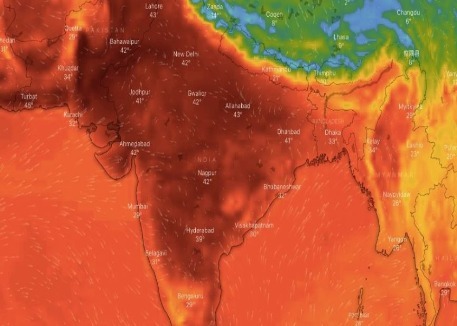
As the nation prepares for 2024, the Indian Meteorological Department (IMD) predicts an even hotter summer with an increase in heatwave days, particularly across the southern peninsula, and central and western regions. Gujarat, Maharashtra, Karnataka, Rajasthan, Madhya Pradesh, Chhattisgarh, Odisha, and Andhra Pradesh are expected to bear the brunt.
Mercury levels have spiked sharply across northwest, west, and central India, including Delhi. These regions also logged two consecutive months, March and April of the hottest weather on record since 1901! The temperatures during summers are typically high across these regions. Still, the magnitude of the spike in mercury levels has been causing concerns around the long-term health and safety of the residents, especially those most vulnerable to such prolonged heatwave.
How does it affect the Indian economy and the Agricultural sector?
The rising temperatures don’t just affect people’s health; they also have significant economic impacts. The scorching heat disrupts agricultural activities, leading to crop failures and reduced yields. The demand for electricity surges as people use air conditioners and other cooling devices, putting pressure on the power supply.
The economic impact of prolonged heatwave is profound, affecting agriculture, causing food price-led inflation, and endangering public health. “The concerns are palpable,” says Madan Sabnavis, chief economist at the Bank of Baroda, particularly as reservoir levels are significantly lower than last year, potentially leading to water shortages.
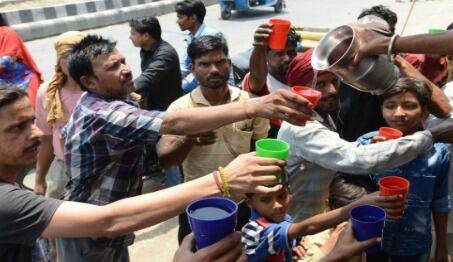
The imminent heatwave season coincides with India’s general elections, which are set to commence on April 19. The combination of extreme heat and electoral responsibilities poses additional challenges, with Union Minister for Earth Sciences Kiren Rijiju emphasising the need for caution.
India’s reservoir levels, currently at 36% of capacity, are crucial for maintaining water supply for drinking, agriculture, and construction. While the arrival of the monsoon is eagerly anticipated, its timing remains uncertain, raising concerns about potential water scarcity.
The agricultural sector, heavily dependent on monsoon rains, faces significant challenges due to low reservoir levels and delayed summer rains. Coarse grains like bajra and jowar might see reduced cultivation, impacting rural livelihoods and food production.
Despite the looming heatwave, there is hope on the horizon as El Niño conditions weaken, and La Niña is anticipated to bring much-needed rainfall during the monsoon season, boosting agricultural productivity. However, the impact of rising temperatures on food prices and inflation remains a pressing concern, with cereals and pulses particularly vulnerable.
Rural demand, driven by farm income, is expected to remain cautious until the Kharif harvest, impacting sectors like fast-moving consumer goods (FMCG). However, the upcoming elections may spur temporary demand for essential goods, offering a potential silver lining amidst the heatwave havoc.
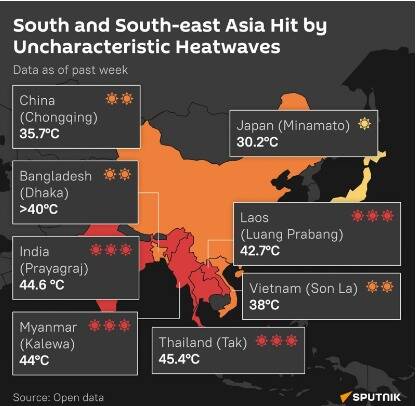
While India braces for another sweltering summer, there’s cautious optimism for relief through timely monsoon rains and La Niña’s cooling effect, vital for alleviating the economic and health impacts of the scorching temperatures. Additionally, industries face challenges due to increased energy consumption and decreased worker productivity.
A Tale of Opposing Climate Forces
El Niño and La Niña are opposite phases of a naturally occurring climate phenomenon known as the El Niño-Southern Oscillation (ENSO), which affects weather patterns and ocean temperatures in the equatorial Pacific region. Here’s a breakdown of each:
El Niño:
- El Niño, meaning “the little boy” or “Christ child” in Spanish, refers to the warming of sea surface temperatures in the central and eastern Pacific Ocean, particularly along the equator.
- During El Niño events, the normal patterns of atmospheric circulation and ocean currents change. Warm waters shift eastward, causing changes in weather patterns globally.
- Effects of El Niño can include:
- Increased rainfall and flooding in some regions, such as parts of South America, East Africa, and Southeast Asia.
- Drier than normal conditions, droughts, and wildfires in other areas, such as Australia and parts of Africa.
- Warmer temperatures in the northern United States and cooler temperatures in the southern United States.
- Disruption of marine ecosystems, affecting fish populations and fisheries.
- El Niño events typically occur every 2 to 7 years and can last for several months to over a year.
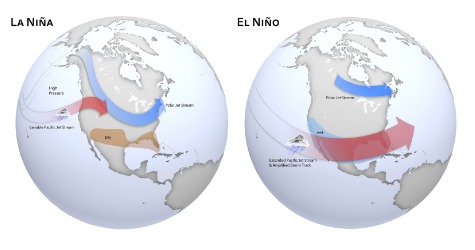
La Niña:
- La Niña, meaning “the little girl” in Spanish, is the opposite phase of El Niño and is characterized by cooler-than-normal sea surface temperatures in the central and eastern Pacific Ocean.
- During La Niña events, the normal patterns of atmospheric circulation and ocean currents also change, but in the opposite direction of El Niño.
- Effects of La Niña can include:
- Increased rainfall in the western Pacific, leads to flooding in countries like Indonesia and the Philippines.
- Drier than normal conditions in parts of South America, particularly in northern Brazil and the Amazon basin.
- Cooler temperatures in the northern United States and warmer temperatures in the southern United States.
- Stronger than normal trade winds, which can influence hurricane activity in the Atlantic Ocean.
- La Niña events typically occur less frequently than El Niño events but can also last for several months to over a year.
Both El Niño and La Niña have significant impacts on global weather patterns, affecting agriculture, water resources, and ecosystems around the world. Understanding these phenomena is crucial for predicting and managing their impacts on society and the environment.
Bracing for Heatwave Havoc: A Nationwide Alert
As summer advances, the Indian Meteorological Department (IMD) raises concerns about impending a heatwave across several regions. Coastal Andhra Pradesh, Tamil Nadu, Puducherry, Karnataka, Goa, Kerala, West Bengal, and Bihar are likely to experience high humidity, adding to people’s discomfort. Substantially high night temperatures pose health risks, especially in east Madhya Pradesh, where temperatures are expected to soar on April 22 and 23.
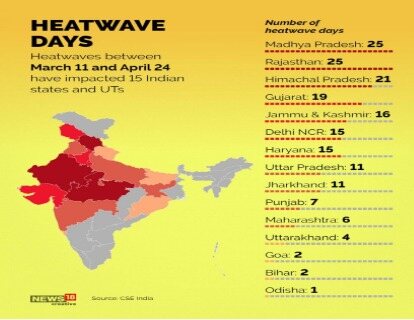
Urban areas face additional challenges due to the urban heat island effect, exacerbating nighttime heat. To qualify as a heatwave, temperatures must reach specific thresholds, with severe heatwave declared when deviations exceed 6.4 notches from the norm.
Despite weakening El Nino conditions, extreme heat is expected during the April-June period, coinciding with the Lok Sabha elections. The IMD predicts four to eight heatwave days in April alone, with Madhya Pradesh, Gujarat, Odisha, Andhra Pradesh, Maharashtra, Bihar, and Jharkhand likely to experience more than 20 heatwave days.
Intense heat strains power grids and exacerbates water shortages. The IMD also anticipates La Nina conditions later in the year, which could impact the monsoon season. A mid-April update suggests above-normal rainfall during the 2024 monsoon season, crucial for India’s agricultural landscape and reservoir replenishment.
Major cities like Mumbai and North Goa are already experiencing severe hot weather. In Odisha, the Special Relief Commission has issued a ‘yellow warning’ for several districts, advising precautions to combat the heatwave. Telangana, Coastal Andhra Pradesh, Yanam, and Gangetic West Bengal are also on high alert.
In Kerala, districts are expected to face unprecedented temperatures, prompting concerns for public health. Several regions may experience rainfall, offering temporary relief. However, states like Jammu Kashmir, West Bengal, Sikkim, and Himachal Pradesh are bracing for thunderstorms and hailstorms over the next few days.
As India prepares for scorching temperatures, awareness, and preventive measures become paramount. It’s a collective effort to safeguard against the heatwave havoc and mitigate its adverse effects on health, infrastructure, and agriculture.
Conclusion
In conclusion, India faces a challenging summer as the heatwave season intensifies, hitting earlier and harder than usual. The scorching temperatures, soaring above 45°C in many regions, are not only uncomfortable but also pose serious health risks, particularly for vulnerable populations.
As temperatures rise, so do concerns about the economic impacts, disrupting agriculture, increasing power demand, and reducing productivity. The 2024 heatwave season, which began in March and extended through April, has broken records across northwest, west, and central India.
As the nation braces for another sweltering summer, awareness and preventive measures are essential to mitigate the adverse effects of the heatwave. It’s imperative to prioritize hydration, cooling measures, and public health initiatives to safeguard against heatwave havoc.
Additionally, sustainable practices and public awareness are crucial in combating the long-term effects of rising temperatures and climate change. With collective efforts, India can navigate through this challenging period and emerge stronger, ensuring the well-being of its citizens and the sustainability of its environment.
-ABHINASH PRITIRAJ
MUST READ:- CLIMATE COUNTDOWN: UNDERSTANDING THE URGENCY OF ACTION





